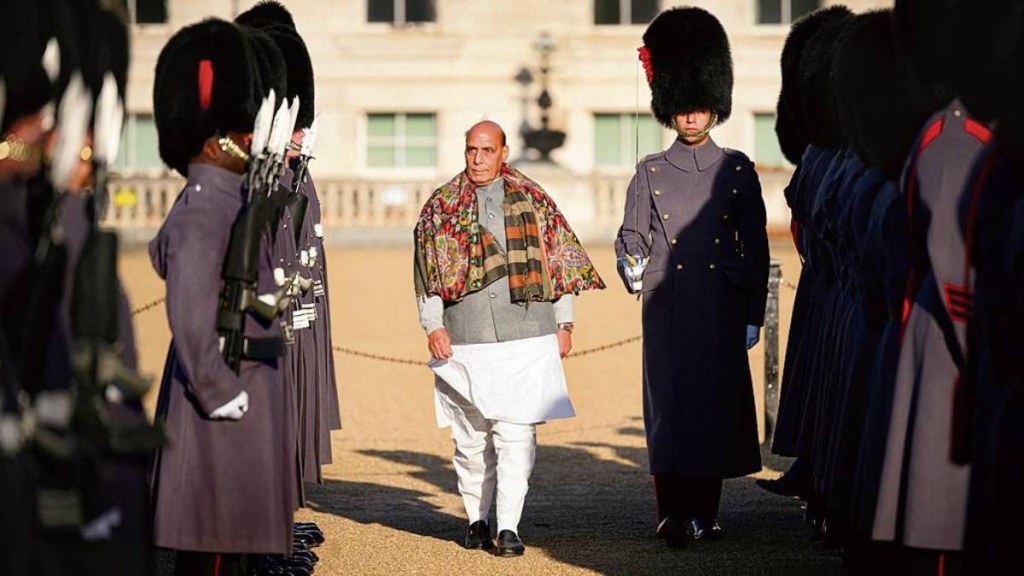Huma Siddiqui
New Delhi, Jan 10
The visit of India’s Defence Minister, Rajnath Singh, to the United Kingdom marked a significant milestone in the diplomatic relations between the two nations. This visit, the first of its kind in over two decades, underlined the commitment of both countries to strengthening ties, particularly in defence cooperation.
The UK Defence Secretary Grant Shapps played a major role in hosting and engaging in discussions that outlined the trajectory of future collaborations.
Outcomes
The visit was not merely symbolic; the tangible outcomes included: one of the key announcements was the UK’s plan to deploy its Littoral Response Group to the Indian Ocean Region later this year. Looking ahead, the Carrier Strike Group is slated to visit in 2025, highlighting a strategic commitment to operational training and collaboration with Indian forces.
This move signifies the growing importance of the strategic relationship between the UK and India, reflecting a shared understanding of the contemporary security challenges that necessitate collaborative efforts. Defence Secretary Grant Shapps underscored the significance of such collaborations, stating, “It is vital that we continue to build on our strategic relationships with key partners like India.” This acknowledgement of shared security challenges emphasizes the necessity of collective action in maintaining a free and prosperous Indo-Pacific region.
The discussions between the two nations went beyond military manoeuvres, encompassing a comprehensive spectrum of collaborative initiatives. Joint exercises, knowledge-sharing platforms, and instructor exchanges were on the agenda, building on the foundation laid by the 2030 India-UK roadmap announced in 2021. The roadmap serves as a blueprint for the future, outlining a strategic vision that goes beyond the immediate horizon, with an eye on shared goals and challenges.
Looking ahead, the UK and India are set to engage in more complex military exercises, culminating in a landmark joint exercise before the end of 2030. This forward-looking approach aims to protect critical trade routes and uphold the international rules-based system, aligning with both nations’ commitment to global stability.
Strategic Relationships
Defence Secretary Grant Shapps emphasized the urgency of building strategic relationships, recognizing the increasingly contested nature of the world. “There is absolutely no question that the world is becoming increasingly contested,” he stated, highlighting the need for collaboration to counter threats and challenges that seek to destabilize and harm both nations.
Electric Propulsion System
Integral to the strategic defence partnership between the UK and India is collaboration with the industry. The two nations are actively working together on electric propulsion systems, technology that will power future fleets.
Additionally, joint efforts are underway in the development of complex weapons, showcasing the depth and breadth of their collaborative endeavours in the defence sector.
The visit witnessed the announcement of several new joint initiatives, adding concrete dimensions to the growing partnership. The launch of Defence Partnership-India, a dedicated office designed to enhance defence collaboration, stands out as a testament to the commitment of both nations.
The commitment to instructor exchanges, a Youth Exchange Memorandum of Understanding (MOU), and a Letter of Arrangement emphasizing research and development underscore the multifaceted nature of the collaboration.
The Youth Exchange MOU is expected to solidify the already strong relationship between the cadet organizations of the two nations. Such initiatives, fostering people-to-people connections, contribute to the long-term sustainability of diplomatic ties. The Letter of Arrangement focusing on research and development signifies a commitment to exploring next-generation capabilities, ensuring that both nations remain at the forefront of defence technology.
Logistics Exchange
An agreement on logistics exchange represents another milestone achieved during this diplomatic engagement. This agreement facilitates the provision of logistic support, supplies, and services between the United Kingdom and the Indian Armed Forces. The scope includes joint training, exercises, authorized port visits, and Humanitarian Assistance and Disaster Relief (HADR) operations. This logistical collaboration strengthens the operational capabilities of both nations, fostering a more agile and responsive defence infrastructure.
The visit by the Indian Defence Minister holds historical significance, being the first of its kind in over two decades. The last such visit occurred in 2002 when George Fernandes visited the UK. Multiple attempts in recent years for an official visit by Mr. Rajnath Singh did not materialize, underscoring the significance of this successful diplomatic mission.
The Memorandum of Understanding signed for a bilateral international cadet exchange program and the Letter of Arrangement on defence collaboration in Research and Development are concrete outcomes of the bilateral talks between Defence Minister Rajnath Singh and his British counterpart Grant Shapps in London. These agreements hold the potential to reshape the landscape of defence cooperation, fostering innovation and collaboration in research and development.
Defence Minister Rajnath Singh expressed satisfaction with the discussions, stating, “Had an excellent meeting with the UK Defence Minister, Grant Shapps. We reviewed the full range of India-UK defence relations.” His sentiments echo the positive atmosphere surrounding the talks, indicating a shared commitment to strengthening the multifaceted relationship between the two nations.
Beyond the diplomatic engagements, Defence Minister Rajnath Singh commenced his visit by paying homage to Mahatma Gandhi at Tavistock Square. This symbolic gesture underscores the historical ties between India and the UK, with Mahatma Gandhi having studied law at the nearby University College London from 1888 to 1891. The ceremonial Guard of Honour at the Horse Guards Parade Ground added a touch of grandeur to the visit, symbolizing the mutual respect and shared values between the two nations.

